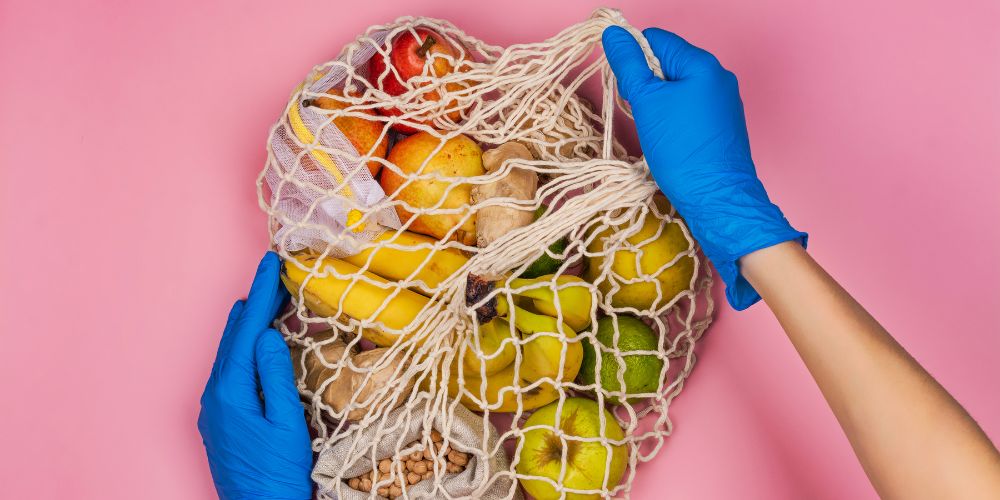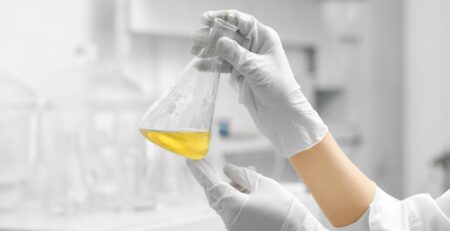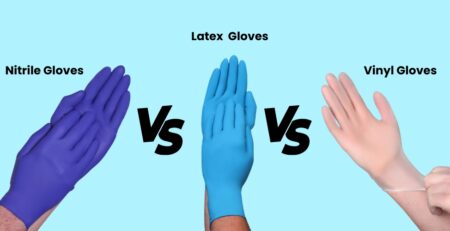
Apr
Are Nitrile Gloves Food Safe?
Gloves are essential for food services or food preparation. They help keep everything clean, reduce the risk of cross contamination and protect you and your customers form illness. Howerver not all gloves are the same.
So, are nitrile gloves safe to use around food?
Yes, they’re not just safe, they’re one of the top options out there. Here’s why they stand out when it comes to food handling.
Why Food Safe Gloves Matter
Your hands can carry millions of bacteria at any given time. Even after washing, some microbes remain. That’s where disposable gloves come in. They act as a clean, dependable shield between your hands and whatever you’re prepping.
When worn and changed correctly, gloves help:
- Stop the spread of foodborne illnesses like Salmonella or Norovirus.
- Keep raw meat, fresh produce, and ready-to-eat items from mixing and causing cross-contamination.
- Keep allergens like latex proteins out of food.
- Protect food from skin oils, odors, and unseen contaminants.
What Makes a Glove “Food Safe”?
You’ll come across a variety of disposable gloves, including latex, vinyl, nitrile, and polyethylene, but not every pair is cleared for direct contact with food. Here’s what distinguishes the food-safe options from the others:
FDA Compliance
In the U.S., food contact gloves must comply with FDA Title 21 CFR Part 177, which outlines what materials are considered safe for contact with food. Any gloves marketed for food use must be made from materials recognized as food-safe and not transfer harmful substances to food.
AQL Rating
AQL stands for Acceptable Quality Level, and it measures the percentage of gloves in a batch likely to have defects (like pinholes). For food-safe gloves, an AQL of 2.5 or lower is the standard. This means no more than 2.5 defective gloves per 100.
Latex-Free
Although latex gloves can be food-safe, the risk of allergic reactions, especially from the proteins in natural latex, has made latex-free gloves the safer bet. Nitrile is a great alternative that’s free from latex allergens.
Powder-Free
Powdered gloves used to be common, but they’re banned by the FDA in medical settings and strongly discouraged in food service. The powder can trap and transfer allergens, cause respiratory irritation, and contaminate food.
What Are Nitrile Gloves Made Of?
Nitrile gloves are made from nitrile butadiene rubber, a synthetic compound that mimics the stretchiness of latex without the risk of allergic reactions. They were created as a solution for latex sensitivity, and now, they’ve become the gold standard for disposable gloves in many industries.
What makes nitrile so special for food prep? Let’s dig in
Why Nitrile Ideal Food Grade Gloves
1. Durability You Can Count On
Nitrile is incredibly strong. These gloves hold up well against:
- Rips
- Tears
- Punctures
- Stretching
That means you can chop, stir, wash, and serve without worrying about glove failure. Thicker nitrile gloves (4–6 mil) are especially useful in commercial kitchens, where speed and safety are top priorities.
2. Heat & Chemical Resistance
Nitrile offers impressive heat resistance, which comes in handy when working with hot pans or foods. Plus, they resist oils, cleaning chemicals, and certain solvents, perfect for fast-paced kitchens where cleanups and cooking go hand in hand.
3. Allergen-Free
No natural rubber = no latex allergens. That’s a big win when you’re serving a wide customer base and can’t risk an allergic reaction due to cross-contact. And since nitrile gloves are typically powder-free, you’re also avoiding another common irritant.
4. Great Fit & Flexibility
Don’t let the toughness fool you—nitrile gloves are still flexible and fit snugly to your hand. That’s key for tasks that require precision, like decorating desserts or plating delicate ingredients.
You’ll keep your dexterity, grip, and touch sensitivity, so your food looks and tastes as good as it should.
5. Color Options for Food Safety
Ever wonder why so many food prep gloves are blue?
That’s because blue isn’t a color found in natural food. So, if a glove rips or a piece falls into the food, it’s easy to spot and remove before it reaches a customer’s plate.
Pro tip: Use different glove colors for different tasks (e.g., black for meats, blue for produce) to instantly minimize cross-contamination risk.
Are All Nitrile Gloves Food Safe?
Here’s the catch—not every nitrile glove is automatically food-safe. Some are made for industrial or medical use only.
What to check before buying:
- FDA food handling approval
- Powder-free
- Latex-free
- AQL rating of 2.5 or lower
- Non-textured or lightly textured for food prep
When in doubt, go with gloves labeled specifically as food service or food handling approved.
How to Use Nitrile Gloves Safely in Food Service
Swap out gloves:
- After handling raw meat
- Before switching food types
- After touching your face, phone, or non-food surfaces
- Every 4 hours (at a minimum)
Don’t Skip Hand Washing
Gloves aren’t a substitute for clean hands. Wash up before and after gloving to stop bacteria from hitching a ride.
Store Gloves Properly
Keep gloves in a cool, dry spot away from heat or direct sunlight. Moisture or UV exposure can break down the material.
Food Prep Scenarios Where Nitrile Gloves Shine
Let’s walk through a few real-world examples:
In the Restaurant Kitchen
Chefs rely on nitrile gloves to move fast and stay clean. From prepping produce to slicing raw fish, nitrile keeps your team protected while reducing the risk of foodborne illness.
At the Bakery
Tactile-sensitive tasks like frosting cupcakes or shaping dough? Nitrile provides enough flexibility and grip to make detailed work feel natural.
During Cleanup
Nitrile gloves double as cleanup champs. Their resistance to soaps, detergents, and disinfectants makes them perfect for dishwashing, sanitizing counters, and more.
Shop Our Food-Safe Nitrile Gloves
Need gloves that check all the boxes for food safety? We’ve got you covered.
Our nitrile gloves are:
- Exam-grade
- FDA approved for food contact
- Durable and comfortable
- Bulk available for commercial kitchens
Final Thoughts: Yes, Nitrile Gloves Are Food Safe
When you need gloves that tick every box, safety, comfort, durability, and allergen-free protection, nitrile is the way to go.
They’re trusted in kitchens, bakeries, food trucks, catering companies, and anywhere cleanliness and food safety are non-negotiable.
Just make sure you’re buying gloves that are FDA-approved, powder-free, and properly stored.
Also read : Types of Gloves and How to Choose Right Glove Material
Frequently Asked Questions
Can you use nitrile gloves to cook meat?
Absolutely. Nitrile gloves are perfect for handling raw and cooked meats. Just make sure to change gloves between stages to avoid contamination.
H3: Are blue nitrile gloves the only food-safe option?
Nope! Black, white, and even purple nitrile gloves can be food-safe, as long as they’re labeled for food handling. Blue is just the easiest to spot if a piece tears off.
What if someone has a sensitivity to nitrile?
Although rare, some people may react to the chemical accelerators used in nitrile glove production. In that case, a vinyl or polyethylene glove might be a safer choice.
Can nitrile gloves be reused?
No. Disposable nitrile gloves are designed for one-time use. Reusing them increases the risk of contamination and decreases protection.
Are nitrile gloves biodegradable?
Traditional nitrile gloves are not biodegradable, but eco-friendly nitrile options are starting to enter the market. Look for “biodegradable nitrile” if sustainability is a priority.



